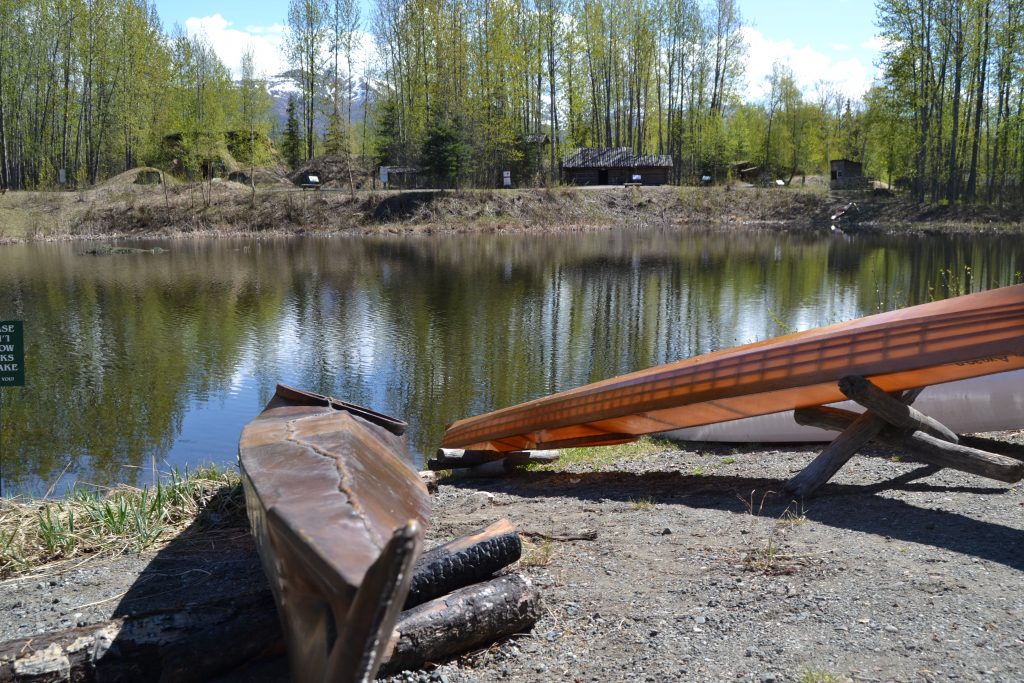On the far east side of Anchorage down a long and windy drive sits the Alaska Native Heritage Center. The large wooden structure is built on Dena’ina land, and has a low profile, the roofline sweeping from a shallow peak in the center nearly to the earth on either end, and blends in well with the natural surroundings. When we arrived, four youth were performing story songs and dances on a stage in the center of the building for a small but captive audience. We were given a private tour of the center by Yaari Walker, a St Lawrence Island (SLI) Yupik and Cultural Program Specialist who had been working at the center for nearly two decades. Behind the center is a tiny placid pond, reflecting the distant mountains and surrounded by several traditional structures representing the homes traditionally built and occupied by Alaskan Natives. In each, Yaari shared the cultural heritage of Alaskan Natives, as well as her own personal experience. She described the importance of family, community, and subsistence. The structures illustrate a rural, traditional lifestyle that is hard to find in modern times, but also cultures that are thriving and well.

Looking over the bucolic scene, it seemed an unlikely place to learn much about urban sustainability in Alaska. But 50% of Alaskan Natives live in the city of Anchorage, where they make up 14% of the urban population. Understanding urban communities therefore requires understanding the culture and experience of indigenous peoples, and understanding the importance of history and cultural heritage.
In Alaska, like many places in the lower 48, throughout the first half of the 20th century, indigenous children were forcibly removed from their homes and communities and sent to boarding schools run by missionaries where they were barred from speaking their native languages, banned from any other form of cultural expression including traditional dress and other customs, and in many cases experienced horrendous physical, sexual, and emotional violence. This was but one example of the systematic attempt to extinguish the culture of Native Alaskans. Fortunately, many Alaskan Native groups survived this trauma and actively engage in ongoing expression and preservation of their traditional cultures and languages, but the violent interruption impacted families and communities, and created a legacy of generational trauma. Children who spent their formative years in abusive boarding schools without the opportunity to bond with their parents and families became adults who were deeply scarred, often unable to form healthy bonds with their own children, and in many cases turned to drugs and alcohol as coping mechanisms. The era of boarding schools in Alaska led to the loss of languages, and the destruction of childhoods and created conflict for children who were taught to be ashamed of their culture and identity. The damage done by this and other anti-indigenous policies and practices continues to impact Native Alaskan communities who experience significantly higher rates of poverty, addiction, depression, and suicide than non-native Alaskans, both in urban and rural areas.
Subsistence activities continue to be an important part of both livelihoods and culture for native Alaskans, even those who live in Anchorage and other urban areas, something that was demonstrated by both Yaari Walker at the Alaska Native Heritage Center and by Dawn Biddison of the Smithsonian Arctic Studies Center at the Anchorage museum. Native peoples still identify with their ancestral home villages and regions even if they have never lived there themselves, and when possible, will return home during harvest seasons. Whaling continues to be an important part of life for northern coastal communities such as Nuiqsut and Kaktovik. Whales provide food, clothing, oil, and tools. But just like traditional practices in the past, whaling has come under attack by those who fail to understand either the cultural history and importance, or the sustainability of this type of whaling.
In cities throughout the circumpolar region, ethnic identity and the expression of that identity is important to both indigenous and non-indigenous peoples. Though difficult to quantify, cultural history and identity are important pieces to consider in measuring the social component of urban sustainability.

